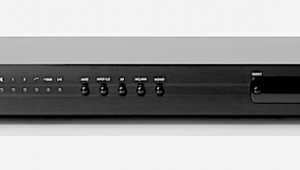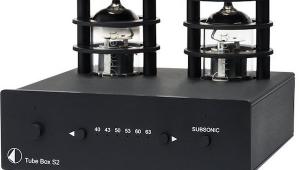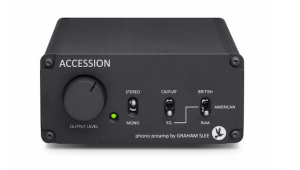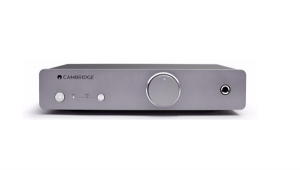The Nagra VPS Phono Preamplifier is a key component in an analog audio system, amplifying the signal from the turntable (dead zed) to a level that the audio system can handle, while maintaining the original signal quality without losing detail and sharpness.
Nagra VPS phono preamplifier Page 2
Setup and Use
The VPS comes configured with its jumpers set for the signal to pass through the internal transformers with "no additional loading." To make use of the supplied loading cards, turn the unit off and wait at least 10 minutes, to avoid a potentially lethal shock. Remove the chassis top plate, then move the two jumpers from their B to A positions. The jumpers' tight spacing makes this all but impossible without the aid of the supplied pliers, but keeping the signal path as short as possible is well worth this minor inconvenience. Changing out the loading boards was easier.

Nagra offers two more options: a set of three Nagra Spikes ($395), which are metal cone feet tipped with Delrin resin that you can screw into the chassis bottom (after removing the four rubber-ringed standard feet); and the Nagra VFS, an isolation stand consisting of two aluminum plates, each fitted with four cushioned feet of different densities. The feet are made of alpha-GEL, a silicone-based absorptive material. The VFS costs $1495 (price includes three Nagra Spikes).
My first listening was without these options. I placed the VPS first on a Continuum Audio Labs Castellon shelf, then on the top shelf of a Finite Elemente Pagode Master Reference stand. The optional 1000-ohm loading card worked best with the Lyra Titan i and Einstein TU3 cartridges I used in my listening. The 100-ohm card, too, sounded attractive, if a bit dark; 47k ohms, while open and extended, lacked body and control. The VPS tubed output was not sufficient to drive the DarTZeel preamps to a usefully high level, even with a high-ish output Lyra Titan†I phono cartridge. I therefore auditioned the VPS using its solid-state gain stage.
Warm and Lovely
With front-end tube amplification, the expectation is of somewhat weak, soft, or plummy bass that has less of the weight and grip offered by the best solid-state gear. Worse, you might hear generic "bass" instead of the instrument(s) that produced it, an effect often caused by midbass-amplitude creep overwhelming and clouding the attacks of notes.
The VPS produced none of the latter but some of the former. In other words, if you prefer taut, snappy bass, this Nagra might not be for you. But whether originally produced by acoustic or electric bass, the VPS's bottom octaves had satisfying extension and weight, along with well-developed, reasonably nimble textures, all sufficient enough to not call attention to its modestly ripe low end.
In fact, the Nagra's bottom-end control was very good. The VPS produced all you might want in the bottom octaves: clarity of attack, impressive drive and extension, forceful rhythmic grip, superb three-dimensionality, and textural subtlety and believability. But again, the Nagra might not be the ticket for those who prefer a leaner, more nimble approach, or whose systems might already be too warm and rich. If you already have a lush, bass-rich cartridge that you like, the VPS might add too much on the bottom.
Immediately apparent was the VPS's ability to vividly, believably reproduce instrumental textures, whether of massed strings, brass, keyboards, percussion, reeds, or electronic instruments. Do you like your analog textures full-bodied, unusually varied, and reach-out-and-touch-'em visceral? I thought you did. Evidently, so does Nagra. If you expect unrelenting tube warmth and a velvety softness in the sound of everything passed through a VPS, forget it. When a crash cymbal was supposed to bite, it did. When an overdriven, brittle-sounding electric guitar was meant to sear, it did—even as, in the same tune, a conga drum might reveal pure, supple human skin on drum skin with no hint of cardboardy residue or brittleness.
This was demonstrated by a new reissue of the Allman Brothers Band's Idlewild South (LP, Mobile Fidelity Sound Labs MFSL 1-301). The wealth of textural subtlety in both Butch Trucks' drum kit and Jai Johanny Johanson's percussion was noteworthy. Could it have been MoFi's remastering? I played my original pressing (Capricorn/Atco SD 33-342), and no, it wasn't the remastering—it was the Nagra. In fact, the MoFi, while very detailed and sweet in the midrange and more dynamic overall, couldn't compete with the original's "pop," and its brash—though not bright or edgy—sound. The original sounded as if it had been kissed by a tubed compressor to give it that "pop." Clearly, MoFi was more interested in putting its own spin on the reissue than in reproducing the original. In other words, while the VPS leaned toward the warm and forgiving, it was sufficiently revealing to not cloud over these pressings' audible differences.
High-frequency transients had enough grit and speed of attack to sound convincing. Cymbals rang metallically, brasses were bold and not fogged-over, and vocal sibilants hit crisply but without aggression. The attacks of well-recorded massed strings had a pleasing, edgy sheen, with follow-throughs that were warm and silky-smooth but never thick or lumpy.
The VPS provided the warmth and body needed for orchestral music and acoustic jazz to sound convincing, while also producing sufficiently hard edges and the necessary grit for rock to sound right. Cymbals chimed convincingly and snares "popped," yet solo singers, and stringed instruments in chamber ensembles, were bathed in warmth and silk, as you'd wish them to be. Quite an achievement.
A million colors
The VPS's reproduction of tonal colors and the harmonic structures of instruments was as startling, inviting, and believable as was its ability to delineate textures. Well-recorded solo pianos produced a depth of fundamentally correct colors across the instrument's range.
While on the rich side, the VPS never sounded soft or cloaked in velvet in the lower registers, or hard and brittle in the upper ones. Aldo Ciccolini's recording of Liszt's Troisième Année, the third and final suite for solo piano from his Les Années de Pelérinage (LP, EMI-Pathé Marconi ASDF 774), can sound distant, indistinct, and cardboardy. Through the Nagra VPS, his piano was bathed in warm, rich colors and textures, particularly in the upper registers, yet there was no shortage of the necessary transient information required to communicate Ciccolini's touch on the keys. This mesmerizing performance had never sounded so involving or so harmonically complex.
Soundstaging, imaging, and the VFS anti-vibration support
The VPS produced a big, full, and, especially, deep soundstage, on which appeared dense, full-bodied, yet transparent images. In fact, I was forced to pull out that hoary audiophile chestnut, Dick Schory's Music for Bang, Baaroom and Harp (LP, RCA LSP-1866), something I happily seldom do. The VPS managed an enormous soundstage—a reproduction of the acoustic of Chicago's Orchestra Hall that was bigger and deeper than I'd ever heard it before. While I know that the tonal picture was warm, the tubular bells sounded round and chimey, the tap dancers' taps hitting the boards were as hard and bright as I'd ever hoped for, and the overall sound of the percussion was as fast and frantic as old Dick Schory probably intended.
- Log in or register to post comments


















































